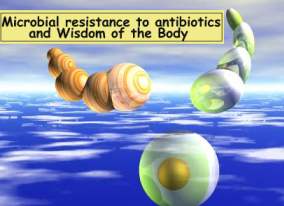
 |
Microbial resistance to antibiotics remains the major concern of medicine. Physicians generally belittle their role in breeding resistant bacteria, hoping that technology will find means to combat them. Yet most technological inovations were already exploited, while resistant microbes thrive. The distinguished scientific journal Science, devoted its recent issue to this topic (1). Scientists continue to focus on cells, membranes, receptors, and genes, while microbes remain nearly unharmed. It is striking that Science continues to ignore the ecological aspect of microbial resistance, as it did in its previous issue on microbial resistance (2,3). Resistant microbes are bred by physicians and this process can be reversed only by baning the use of antibiotics, which at first sight might seem utterly unrealistic and unthinkable; like rejecting other technological innovations, e.g., cars and computers. Yet the threat of an all-resistant bug to our society is imminent. Why not then consider this posibility?
Wisdom of the body
The interaction between host and microbe is bi-directional. The invading
microbe triggers in the host anti-microbial measures, e.g., inflammation and
immunity. When these essential functions are deficient the host is endangered.
Even the most potent antibiotic cannot save a patient with agranulocytosis.
These measures are regarded here as Wisdom of the Body (4,5) that evolved in
a Darwinian fashion. Our organism is well equpped to deal with microbes otherwise
the human species would have succumbed to microbes long ago (6). The wisdom
of the body anticipates microbial invasion and knows how to handle it; the organism
is therefore regarded by Guyenot, as the "best among physicians" (7). Could
this wisdom be apllied to liberate the organism from its dependence on antibiotics?
With the discovery of penicillin, medicine lost its interest in the wisdom
of the body, since the drug seemed to control microbes better than the organism;
it was hamless, with minimal side effects. This advantage gradually dvindles.
As microbes become more and more resistant, the therapeutic margin of safety
of antibiotics declines and side effects become more abundant.
Infection as experience
Medicine regards microbes as a threat to health and attempts to eliminate
them altogether. On the other hand, microbial infection is an important experience.
Immunity is established only through exposure to microbes; external hazard promotes
the wisdom of the body. A correct antibiotic treatment should therefore maximize
experience gained from infection while minimizing microbial threat to the organism.
Antibiotics should be withheld whenever the threat to the organism is small.
Even in more dangerous situations treatment should be postponed without endangering
the patient too much. Over-protection from microbes might be harmful since withholding
valuable experience.
Our dependence on antibiotics is similar to the dpendence on steroids.
Initially these wonder drugs were regarded as harmless panacea for many diseases,
untill their grave side effects were discovered. Today they are perscribed with
utmost caution, which should be done also with antibiotics. Only by training
our organism to resist microbes, it can be freed from its dependence on antibiotics,
which is achievable by deepening the experience gained by infection. It can
be achieved also by other means, e.g., immunization by a weakened bug, or the
anamnestic reaction, when one strain of microbes induces immunity to other strains
as well.
The ecological role of antibiotics
Antibiotics are natural substances what then is their real function in nature?
Obviously not to protect the humans from infection. Since most antibiotics are
bacteriostatic and not bacteriocidal they might serve as habitat outliners.
Many species have means to specify the borders of their teritory, preventing
other species from entering it. By secreting penicillin the moldkeeps bacteria
out from its niche.
Antibiotic substances in the human organism
Does our organism produce similar niche outliners? A normal human being
hosts about 1.2 kilograms of bacteria; the bulk are in the gut (8). Some are
potential killers and yet they thrive without harming us. How do we protect
ourselves against our own flora? Not by immunology as is generally postulated.
The interaction between an antibody and microbe is generally bactericidal, since
activating the complement system, while our flora florishes.
Recently a Ciba symposium was devoted to this topic (9). Small peptides,
e.g., cecropins, magainins, defensins and serprocidins, act like antibiotics.
They are secreted by epithelia and other tissues; are bacteriostatic and could
act as niche outliners. A new facet of the wisdom of the body.
References
1 Resistance to Antibiotics. Science 264:359-394,1994.
2 Science 257:1036-1038,1992.
3 Zajicek G. How to diminish microbial resistance to antibiotics?
The Cancer J. 6: 52,1993
4 Cannon WB. "The Wisdom of the Body". Norton, New York, 1932.
5 Zajicek, G. The Normal and the Pathological. Cancer J. 7: 48-49,1994.
6 Zajicek G. What is disease? Cancer J. 4:296,1991.
7 Canguilhem G. Le normal et le pathologique. translated into English by
Fawcett CR, Cohen RS. Zone Books New York 1991, p. 130.
8 Bocci V. The neglected organ: Bacterial flora has a crucial immuno-stimulatory
role.
Persp. Biol. Med. 35:251-260, 1992.
9 Gabay EJ. Ubiquitous Natural Antibiotics. Science 264:373-374,1994.